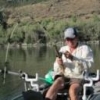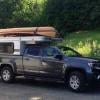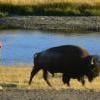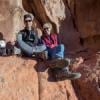
Tire Pressure?
#11

Posted 01 October 2013 - 03:32 AM
Fool Proof To Use The Entire Tread As The Factory Designed. Get Your Pressures Empty And Loaded...
If You Purchased Tries With A Thicker Ply Sidewall And Higher Load Capacity, Common Sense Would Tell Me That I'd Need Less Air In The Tires (Empty) Than The Stock Recommended Pressure On The Door Sticker To Reach The Full Tread Use On The Face Of The Tire. Otherwise I'd Likely See Premature And Uneven Wear... When You Add Load, You Will Jam The Air In Depending On The Factors In The Article. Ymmv
#12

Posted 02 October 2013 - 12:57 AM
ya 40 lb's all around with the camper on is a good idea.
I have a toyota 2001/ Eagle w/ an exra leaf, airbags, and C class ties of same measure ...holds up great
Edited by buckland, 02 October 2013 - 12:59 AM.
2016 Duramax 2.8 Diesel long bed Colorado 4WD with 2011 Eagle
#13

Posted 06 October 2013 - 12:10 AM
I have LT 265/75 R16 C rated,Goodyear Wranglers, Max load 2400# @50# psi.This is side wall info.The factory for my 02 Tundra is front 26,rear 29 empty.
I have been running 45 rear 35 front.I keep an eye on the wear mainly in the center of the tread.
Too much air will wear the center/too low will wear the side of the tread.
I have a "tread depth measuring tool",a few minutes of time to check the depth works for me.I do a measure before a long trip and after.
So far I have been able to keep a fairly even wear to the tread.
For those of us who live in California,remember that if you take your truck in for a service the shop will set the pressure to the door sticker,not what you have in them.I always strongly tell the shop not to change the pressure that I have set them at.They can check all they want but not to change from what I tell them.
This all works for me.My rig goes down the road very nicely and has a nice ride.The tires came with the used Tundra when I bought it.At first I thought the tires would make a lot of road noise due to the tread design,but they are nice and quiet.
Frank
2002 Tundra AC TRD 4WD Limited 2009 ATC Bobcat loaded http://sharychic.blogspot.com/
#14

Posted 06 October 2013 - 03:27 AM
I just ordered another set of BFG AT's after getting 26k/3 years out of the first set, which included a fair amount of rough off road miles. I could probably get 30k of out the set, but winter's coming (we live in snow country) and I've got trips planned that I prefer to have fresh rubber on the road. ![]()
My used 06 Tundra AC came with 18" wheels, so I'm running LT 265/65 18's, and have invested in a matching rim for the spare (note to self: always check the spare for matching rim/tire when shopping for a truck). The sidewalls are pretty beat with a number of gashes, but we never had a flat. ![]() We're similar to Frank and typically run 35-40 front and 45-55 rear. I vary the pressure relative to a highway miles trip versus a local run up the back roads. I also air down frequently in the 25 psi range and will limp it home 30 miles without breaking out the compressor. Overall, the wear is pretty even across the tires. I should also mention I've had the tires rotated twice in the 26k usage.
We're similar to Frank and typically run 35-40 front and 45-55 rear. I vary the pressure relative to a highway miles trip versus a local run up the back roads. I also air down frequently in the 25 psi range and will limp it home 30 miles without breaking out the compressor. Overall, the wear is pretty even across the tires. I should also mention I've had the tires rotated twice in the 26k usage.
2021 RAM 3500 Crew 4x4, 6.4 hemi/8 speed trans with 4.10 gears, Timber Grove bags, Falken Wildpeak 35" tires.
OEV Aluma 6.75 flatbed, Bundutec Odyssey camper on order for 2024
For this year we're still using our 2008 FWC Hawk with victron DC-DC charger, 130w solar, MPPT controler
with 2000w inverter and external 120v output and 12v solar input with 100w portable solar. http://lighthawkphoto.com
#15

Posted 14 March 2014 - 09:41 PM
Interesting topic: Answers here and many other places are all over the place. I think Kilroy's eyeball method is correct. Tundra with a FWC Hawk full of water, gear, and 3-4 people using the BFG AT should be around 40-45 psi according to this chart.
http://www.titantalk...si_per_load.jpg
I will be going out on my "Maiden Voyage" tomorrow. If I get a chance I will have someone determine the front and rear axle weights.
K-Os
Relax, nothing is under control
#16

Posted 14 March 2014 - 11:11 PM
On my Tundra DC and base package hawk my front axle is 3100. Rear axle is 3680, and the whole truck is 6700.
#17

Posted 30 March 2014 - 12:11 AM
LT tires carry less payload when inflated to the same pressure as identical sized P metric tires.
E rated 10 ply tires for a half ton or Tundra are overkill for the intended payload. "D" rated tires are a better choice.
#18

Posted 30 March 2014 - 03:40 AM
An old thread come back to life... This prompted me to do some more research. Opinions are all over the map out there in the internets. Tire Rack has a nice site with lots of info. http://www.tirerack.com/tires/tiretech/techpage.jsp?techid=195
From the site: Quote: "(snip) The above chart correctly shows that an extra load tire is not rated to carry any more load than a standard load tire when both are inflated to the same pressure (up to the standard load tire's "maximum load" pressure. This is because a tire's load capacity is a function of its size (which determines the size of the "air chamber"), its construction (which determines how much pressure can be held) and the actual air pressure used (which determines how many air molecules are forced inside the chamber). All tires with equivalent physical dimensions carry equivalent loads (until they reach their maximum load pressure). (snip)" End quote.
Higher load rated tires are constructed to hold more air pressure which increases the load carrying capacity.
265 70 R16 LT Max load 2835 lbs at 65 psi max pressure
265 70 R16 P Max load 2185 lbs at 44 psi max pressure
Tacoma GVWR is 5350 lbs or 1337 per tire. Even assuming overloading to 6000 lbs that is 1500 lbs per tire.
The recommended tire pressures on the door pillar take the GVWR into account. Assuming you are running the same tire size as OEM, my interpretation is that there is no point in inflating the tires much beyond the recommended pressure of 29 psi front and 32 psi rear, no matter the load rating of the tire. It simply decreases ride quality and tire performance. You should never be so overloaded as to require higher pressures. The benefit of the higher load rating comes in stiffness of the sidewall which helps in cornering, and better puncture resistance in off road situations. YMMV. ![]()
#19

Posted 30 March 2014 - 03:46 AM
Just A Thought...
0 user(s) are reading this topic
0 members, 0 guests, 0 anonymous users


















